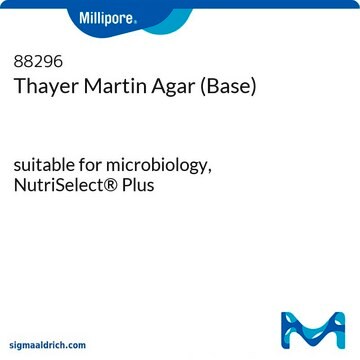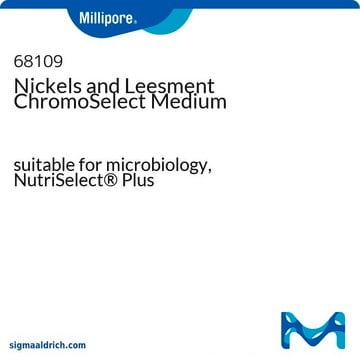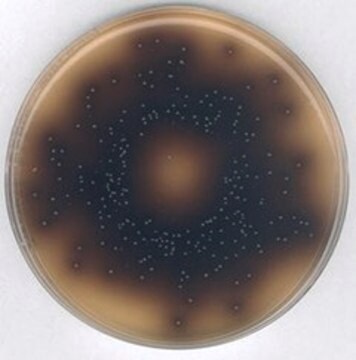55420
CLED Agar
suitable for microbiology, NutriSelect® Plus
Sinonimo/i:
BROLACIN Agar, Bromothymol-blue Lactose Cystine Agar, Cystine-Lactose-Electrolyte Deficient Agar
About This Item
Prodotti consigliati
Sterilità
non-sterile
Livello qualitativo
Forma fisica
powder
Durata
limited shelf life, expiry date on the label
Composizione
agar, 15 g/L
beef extract, 3 g/L
bromo thymol blue, 0.02 g/L
casein enzymic hydrolysate, 4 g/L
L-cystine, 0.128 g/L
lactose, 10 g/L
peptic digest of animal tissue, 4 g/L
Produttore/marchio commerciale
NutriSelect® Plus
tecniche
microbe id | utilization test: suitable
microbiological culture: suitable
pH finale
7.3±0.2 (25 °C)
applicazioni
clinical testing
environmental
food and beverages
microbiology
Compatibilità
nonselective and differential for Enterococcus spp.
nonselective and differential for Escherichia coli
nonselective and differential for Klebsiella spp.
nonselective and differential for Lactobacillus spp.
nonselective and differential for Proteus spp.
nonselective and differential for Pseudomonas spp.
nonselective and differential for Salmonella spp.
nonselective and differential for Staphylococcus spp.
nonselective and differential for Streptococcus spp.
nonselective and differential for coliforms
Descrizione generale
Applicazioni
Nota sulla preparazione
Nota a piè di pagina
The designations basic, plus, or prime are added to indicate the quality control level, from basic quality control to standard QC plus to prime for full regulatory compliance.
Note legali
Codice della classe di stoccaggio
11 - Combustible Solids
Classe di pericolosità dell'acqua (WGK)
WGK 3
Punto d’infiammabilità (°F)
Not applicable
Punto d’infiammabilità (°C)
Not applicable
Dispositivi di protezione individuale
Eyeshields, Gloves, type N95 (US)
Choose from one of the most recent versions:
Possiedi già questo prodotto?
I documenti relativi ai prodotti acquistati recentemente sono disponibili nell’Archivio dei documenti.
I clienti hanno visto anche
Articoli
Chromogenic media enable the selective detection of S. aureus, which produce bluish-green colonies that are clearly differentiated from other species.
An article concerning the detection, identification, differentiation, and cultivation of Pseudomonas species.
Streptococci- Overview of Detection, Identification, Differentiation and Cultivation Techniques
Salmonella, with 2,300+ serotypes, causes half of food-borne illnesses, often from dairy, poultry, and eggs.
Il team dei nostri ricercatori vanta grande esperienza in tutte le aree della ricerca quali Life Science, scienza dei materiali, sintesi chimica, cromatografia, discipline analitiche, ecc..
Contatta l'Assistenza Tecnica.














